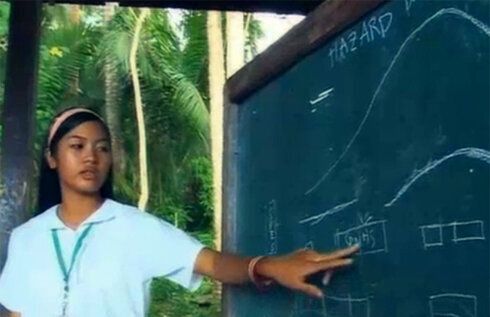
The shocking news on Tuesday of the attempted assassination of a child advocate came two days ahead of big celebrations to launch the International Day of the Girl Child and the Because I am a Girl (BIAAG) Campaign. It unwittingly helped to throw a huge spotlight on the plight that girls face around the world, according to my colleague Kelly Hawrylyshyn who has contributed the following thoughts on the link between girls and their role in reducing the risk from disasters.
This week was a double jackpot for those of us who work on promoting girls rights.
On Thursday we celebrated the first International Day of the Girl Child - a long fought advocacy achievement for Plan International's Because I Am A Girl (BIAAG) campaign. On Friday, the 'icing on the cake' is the International Disaster Risk Reduction (DRR) Day focusing on Women and Girls - the [in]visible force of resilience. And, sadly, this week, we also witnessed the shooting of 14-year-old Malala, a young advocate for girls' rights in Pakistan.
Never has the plight of girls received so much visibility in the span of just one week.
From Pakistan to Zimbabwe, millions of girls across the globe are facing daily risks that endanger their health, violate their dignity, deny them an education and curtail their childhood. The increase in disaster and climate risk is one more challenge that girls face. New research by Plan in South Asia uncovers how climate-related disasters are exposing more girls in the region to gender-based violence, early forced marriage, child labour, family break-ups and barriers to their development and learning.
These disheartening, and too often, invisible realities expose the crucial need to empower girls to learn to better protect themselves from the plethora of risks they face, and in turn contribute to the safety of their families and wider community.
Plan's work on DRR has evidenced the transformative role that girls can play in building their communities' resilience. Our work has shown that once girls are granted access to information and given support to participate and share their voices, they do play a leading role in safeguarding themselves, their families, and their wider communities from disaster risks.
Supporting girls to claim their space requires commitment, resources and hard work to tackle entrenched power relations between adults and children; deep rooted gender norms at household and community level; complex socio-economic barriers that make girls invisible in their societies; and widespread attitude changes in the media and other institutions.
Fifteen year old Honey from the Philippines and 13 year old Cindy from El Salvador are two great examples of how girls can contribute to disaster risk reduction and save lives.

In her community of Santa Paz, in the Philippines, Honey mobilized her high-school of 379 students and their parents to relocate their school to safer grounds. This campaign started after she learnt, through a disaster risk reduction programme conducted by Plan at her school, that they were all in danger of being buried in a landslide.
Despite opposition from school vendors, some parents and local government authorities, Honey stood her ground on prioritising the safety of her schoolmates and teachers, and led a community-wide referendum on the issue. The decision to move won by 101 to 49 votes. She then went on to successfully lobby the Province's governor to provide safer premises in an area that was no longer exposed to landslide risks.
At the other end of the globe, in the community of Cangrejera in La Libertad, El Salvador, 13 year old Cindy and her family suffered loss during Hurricane Stan back in 2005. Since 2007 Cindy actively participated in Plan's Child Centred DRR programme where she learnt how to develop risk maps, create action plans and contribute to better disaster preparedness in her community.
With her new-gained knowledge and skills, Cindy swung into action when Tropical Storm Ida struck the area four years later. Her school was turned into an emergency shelter and she helped with running child-friendly spaces to help protect displaced young children and give them a sense of normalcy during the emergency. By 2011, Cindy has become a well-respected community leader and radio presenter. When Tropical Storm-12 struck that year she used her radio programme on CESA FM to broadcast disaster preparedness messages and followed up with talk-shows holding local authorities to account for their responsibility to act on disaster risk reduction.
Honey and Cindy are two remarkable girls that bring to light the role that many other girls living in disaster-prone communities are, or could, be playing. It is high time for girls to be put on the map and their contributions to resilience to be made visible.
In marking International DRR day, Plan together with Oxfam, the Gender and Disaster Network, and Huairou Commission set up the Women and Girls on the Map initiative to showcase global action and make the contribution of women and girls' to DRR more visible.
Amid all the visibility and endorsements this week in support of girls and their resilience - from Ban Ki Moon to Queen Rania of Jordan - let us hope the commitments made do not fade away, and that we truly take action to make this a gender transformed year for DRR. By joining forces we can empower more girls and women to become visible forces for resilience.
- Kelly Hawrylyshyn, Disaster Risk Reduction Advisor, Plan UK contributed this blog
